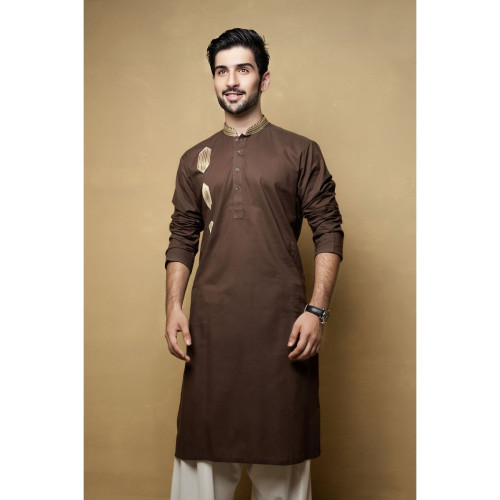
Kurtas
A traditional men's kurta worn in India is a versatile and popular ethnic garment. It's often worn for various occasions, from casual gatherings to formal events. The kurta is a long tunic-style shirt that can vary in length, typically reaching the knees or slightly below. It is paired with different types of bottoms, such as churidar pants, pajama pants, or even jeans, depending on the occasion and personal preference.
Here are some key features of a traditional men's kurta:
1. **Fabric:** Kurtas are made from a variety of fabrics, including cotton, silk, linen, and blends. The choice of fabric depends on the occasion and the weather. Lighter fabrics are preferred for hot climates, while heavier fabrics like silk are chosen for formal occasions.
2. **Design and Embellishments:** Kurtas come in various designs, patterns, and embellishments. Some are plain and simple, while others have intricate embroidery, mirror work, sequins, or other decorative elements. The design can range from minimalistic to highly ornate, catering to different tastes and occasions.
3. **Neckline:** The neckline of a kurta can vary, with styles like the classic round neck, V-neck, band collar, and more. The neckline design can contribute to the overall look and feel of the kurta.
4. **Length and Silhouette:** Kurtas can be short or long, but they usually have a loose and comfortable fit. The silhouette can be straight or slightly tapered, depending on the fashion trends and personal preference.
5. **Sleeves:** The sleeves of a kurta can be short, long, or three-quarter length. The sleeve style can also vary, with options like straight sleeves or sleeves with cuffs.
6. **Buttons and Placket:** Many kurtas have a buttoned placket in the front. The number of buttons can vary, and some kurtas might have decorative buttons.
7. **Side Slits:** Most kurtas have side slits at the hemline, which allows for ease of movement and a stylish look.
8. **Colors:** Kurtas come in a wide range of colors, from traditional whites and pastels to vibrant and bold shades. The color choice often depends on the occasion and personal preferences.
9. **Occasions:** Kurtas are suitable for various occasions, including festivals, weddings, religious ceremonies, casual outings, and formal events. The level of embellishment and the choice of fabric can determine whether the kurta is suitable for casual or more formal occasions.
10. **Accessories:** To complete the traditional look, kurtas are often paired with accessories like mojari (traditional footwear), a stole or shawl, and sometimes a turban or headgear for special events.
It's important to note that the style of traditional men's kurtas can vary across different regions of India and among different cultures. Each region might have its own unique take on the kurta, reflecting local traditions and aesthetics.

